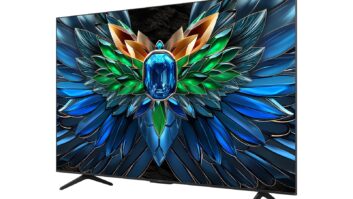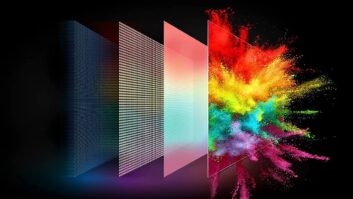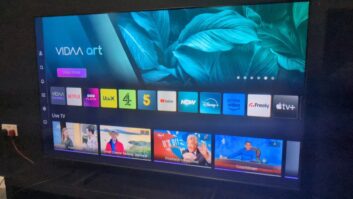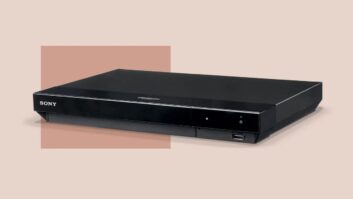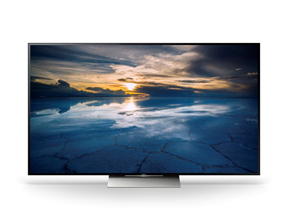
Sony revealed the pricing and ship dates of its latest 4K Ultra HD TVs but wouldn’t divulge specifications such as brightness levels or color gamut because “picture quality is not only about numbers,” said TV business director Sunil Nayyar.
The company is chasing quality, not numbers, he said.
In its 4K lineup, Sony is expanding its selection of 4K TVs with high dynamic range (HDR), bringing Open HDR technology to all seven of its new 4K models. The company offered two 4K TVs in its 2015 lineup with HDR-upgrade capability.
The seven TVs are available today (February 16) for presale and be will available in March at Amazon, BestBuy.com and other authorized dealers.
The product lineup consists of:
- 55-, 65-, 75-, and 85-inch models in the XBR-X850D series at suggested retails of $2,499, $3,499, $4,999, and $9,999, respectively.
- the $7,999 75-inch XBR-X940D model.
- and a $3,299 55-inch model and a $4,999 65-inch model in the XBR-X930D series.
Black levels: The X930D models feature proprietary Slim Backlight Drive, a grid-array edge-lit local-dimming technology said to deliver the benefits of full-array local dimming while keeping the display thin. The grid array achieves more dramatic contrast by distributing the light source more precisely to each specific zone of a screen, the company said. The X930D models are so thin that, when hung on a wall, they stick out only 36.7mm (1.44 inches), the company added. Large areas of the displays are only 0.47-inches-thick.
All of the 2016 4K TVs feature edge-lit frame dimming except for the 75-inch X940D, which features direct LED full-array local dimming and is promoted as delivering near-OLED black levels. The company said the TV’s black levels are very close to those of Sony’s OLED reference monitor, which is used by studios and broadcasters.
Flight to quality: Whatever their specs, the performance of all seven models will exceed that of competing 4K HDR TVs, said TV product technology manager Philip Jones. The company is “confident” of exceeding competitors’ quality, he said, because of such technologies as X-tended Dynamic Range Pro, which appears in the X930D and X940D series to improve contrast. He also cited Triluminos display technology in all series to deliver a wide color gamut. All models also get the company’s X1 processing chipset to enhance clarity, color and contrast. In this year’s 4K TVs, he noted, the X1 chipset get a new algorithm to further upgrade picture quality compared to the X1 chipset used in Sony’s 2015 TVs.
Color gamut “is just a measurement of the panel,” Jones said, but Sony’s X1 processor “can use all the colors correctly to maximize the use of color.”
Most of the company’s 2016 TVs will be 4K because the company is focusing on premium products, said Nayyar. The 4K lineup also reflect the company’s focus on picture quality, design, and user interface, he said.
Thinner bezels: To enhance their design, all of the 4K TVs feature thinner bezels than last year. “The TVs are almost all picture,” said Nayyar. To reach that goal, all 4K TVs this year feature downfiring speakers, whereas some 2015 4K models came with speakers on the left and right sides of the display. The decision to eliminate side speakers reflects consumers’ inclination to add soundbars or use separate speakers as their displays go up in size, Nayyar said.
Google TV: All of the new 4K TVs run Google’s Android TV OS, adopted by Sony in 2015, because a proprietary OS would limit consumer options, said Jones. Android TV’s advantages include voice search in 42 languages, access to the Google Play app store, and Google Cast.
Via a planned app designed specifically for the Sony TVs’ UI, the TVs will control a Logitech Harmony home-automation hub along with hub-connected home entertainment products and such IoT devices as lights.
The TVs will launch with Android 5.0 but will get an Android 6.0 Marshmallow upgrade later on. The company’s 2015 Android TVs will also get a 6.0 upgrade at some point, the company said.
The TVs also feature PlayStation Now technology to stream PS 3 games to the displays from the cloud via Wi-Fi a/b/g/n/ac.
HDR plans: To stream HDR content, the company is sticking with HDR 10 and isn’t including Dolby Vision. “Most content so far will be HDR 10, so we’ll focus on this first,” said Rei Abo, senior TV product marketing and planning manager.
The HDR TVs will be branded with Sony’s new “4K HDR Ultra HD” logo, which will be used across HDR-compatible Sony products from filming to display devices and services. “We want to brand under one umbrella,” Nayyar said. The logo will indicate that the TVs deliver 4K HDR and that Sony delivers the best HDR quality, he contended. The company hasn’t decided if it will seek Ultra HD Alliance (UHD-A) certification of 4K TV performance for its TVs. Certified TVs could wear the alliance’s Ultra HD Premium logo.
All of the new TVs will also stream HDR 4K content from Sony’s planned 4K streaming service, which will deliver Sony Pictures 4K movies in HDR to the Android TVs. It will also allow viewing of a user’s purchased UltraViolet movies and TV shows. The service will launch sometime this year.
Demos: To ensure consumers appreciate the benefits of Sony HDR TVs, Sony is upgrading the Sony Online Experience on the Amazon web site to help people better understand HDR, wide color gamut, and local dimming technology, said Will Chin-Lee, TV product and information manager.
Sony shop-in-shops in Best Buy stores and regional chains will also be upgraded with interactive split-screen demos to demonstrate the technologies. Best Buy’s Sony shops are manned by Best Buy employees who are Sony specialists, while the shops in the regional chains are demo areas that aren’t manned by Sony specialists.





